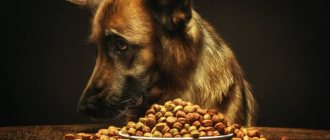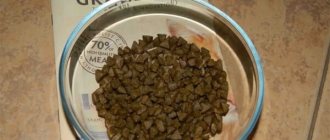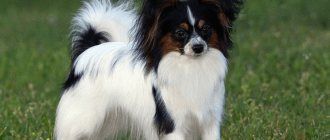Many dog owners choose dry food as daily food for their pets. This is a simple, comfortable and safe way to get a fully balanced diet, taking into account all the health and development of your pet. You can learn more about the advantages and disadvantages of the product in the article “Is it better to feed your dog dry food or natural food?” In this article we will tell you what types of food there are, what the difference is between them and how to choose food for your dog.
Criteria for choosing dry food
The pet products industry is keeping pace with consumers by producing an increasing number of specialty products. The large assortment of bright packaging on store shelves can be explained quite simply - there are entire dedicated lines of food for different breeds of dogs. Well, how to choose the right dry food for your dog with such a variety? The size and age of the animal, health status, level of physical activity, and tendency to allergic reactions are taken into account. Attention is paid to the prevention of breed-specific diseases. The amount of proteins, fats and vitamin and mineral supplements in the food are selected in such a way as to best meet the needs of the dog’s body.
For example, for some breeds (large, but with a slow metabolism), food should be nutritious, but at the same time low in calories. Puppies and large adult pets need a diet with a high protein content and a small percentage of fat. This type of food also contains complexes of useful substances to maintain healthy joints.
Small and decorative dog breeds are mostly active, with a high degree of nervous excitability. These dogs often suffer from dental disease and bone problems. Food for small dogs is rich in linoleic acid and B vitamins. The optimal combination of nutrients in food for them (Yorkie, Chihuahua, Maltese, Toy Poodle, Spitz, etc.) is designed to maintain the health of the nervous system, strengthen the skeleton and prevent tartar .
How to choose food for dogs of different ages? Manufacturers have identified age groups. From the age of two months, puppies can be given Puppy food. They contain the right amounts of nutrients, vitamins, minerals and trace elements that satisfy all the needs of an actively growing, restless baby. Upon reaching six months of age, dogs are considered adolescents and are switched to Junior food. It is rich in protein and minerals for the development of strong healthy skeleton and teeth. At 12-15 months, the dog becomes an adult and can switch to Standard type food - the most balanced, energy-rich product. For dogs over seven years old, the Senior line of food is available.
Types of dry food
In addition to standard feeds, there are several other types of specialized feeds:
- for sick and convalescent dogs;
- for pregnant and lactating bitches;
- for dogs participating in sports competitions with high physical activity;
- for dogs with obesity or cardiovascular diseases;
- for pets prone to allergic reactions.
Taking into account the age and health of your pet, you can choose the right dry food for your dog. A carefully selected balance of proteins, fats, carbohydrates and mineral supplements fully meets the needs of the animal’s body at a certain point in its life.
Feed classes
Like many other products, dog food has several qualitatively different types - classes. They differ in price, composition and quality of raw materials used for production. To choose the right dry dog food, you need to understand the difference between them, what is included in the composition and what affects the quality of the product.
Economy
The simplest and cheapest food belongs to the economy class. As a rule, the packaging does not indicate what meat the product is made from, which means that there is no meat in the composition. It is replaced by food waste (feathers, skins), meat and bone meal and offal, and soybeans. Economy class feed has low energy value. Accordingly, the dog needs more food to satiate. Cheap feeds do not contain vitamin and mineral supplements - you will have to select and purchase them yourself. Plus, the dog’s body often reacts negatively to such foods. The consequence of regular feeding with a low-quality product can be indigestion, deterioration of the coat and skin, and allergies. As a result, the savings are quite dubious, considering the cost of visiting a veterinarian and treating the dog.
Premium
Premium food is only slightly different from economy food. The raw materials for this product are also of low quality, consisting mainly of waste from the meat processing industry and by-products. In premium food, the protein content, and therefore the nutritional value, is higher than in the economy class. But this is unlikely to happen due to the addition of pure meat. Manufacturers use preservatives and flavor enhancers.
Economy and premium food are budget-friendly, but often the choice is limited to just a few types. This does not make it possible to choose a diet for a pet with special needs. In addition, it is necessary to give the dog vitamins and select the optimal complex of minerals and trace elements to maintain healthy teeth, coat and internal organs.
Super premium
Super-premium dry food is made from high-quality products. They contain natural meat and fish, the manufacturer indicates which ones on the packaging. Most often beef, lamb and chicken, different types of fish (tuna, salmon). This class of food also contains eggs, cereals, vegetables and vitamin-mineral complexes.
Super-premium food has the advantage over cheaper food of being able to select a diet for a dog taking into account age, physical activity and other characteristics.
Holistic
Holistic food is a product of the highest quality. To produce this food, we use only high-quality raw materials suitable for human consumption. If by-products are included in the composition, the manufacturer reports this on the packaging, making sure to indicate what exactly it is. Using only natural meat, vegetable fats, pure grains and selected vegetables, probiotics, vitamins, minerals and trace elements makes the product energetically valuable, healthy and completely balanced.
Holistic food is the most natural and safe, satisfying all the needs of a dog’s body at any age and condition. This cannot but be reflected in its price - this food is quite expensive, but it allows you to save on nutritional supplements and visits to the veterinary clinic.
Compound
Let's figure out what ingredients you should pay attention to when purchasing.
Squirrels
Any dog food should primarily contain proteins necessary for tissue growth and repair. Ideally, the amount of meat contained should be at least 30–40%. The best digestible foods are beef, lamb, chicken, turkey, and rabbit.
In economy-class food, part of the meat product is replaced by offal: kidneys, tripe, lungs, etc. Meat flour is used for dry food. Some manufacturers contain dehydrated plant and animal proteins in their economy-class feeds, but they can cause allergies and are less digestible.
Fats
Fats in food are necessary for the normal functioning of the dog’s body - transporting nutrients and producing hormones. In addition, they are a concentrated source of energy.
Animal fats (usually chicken and fish) and vegetable oils (most often flaxseed) are most often added to dog food. They should be up to 18% of the total volume.
Carbohydrates
Carbohydrates in animal feed are represented by cereals, potatoes or flour made from them. Cereals, when broken down in the stomach, turn into an important source of energy - glucose. The percentage of carbohydrates in the feed should be no more than 5–8% of the total volume.
Wheat and corn, which are rich in the allergenic gluten, are not the best sources of carbohydrates. It is advisable that the macronutrients be represented by brown rice, millet or barley.
There are grain-free dog foods, but most researchers agree that they can be harmful to animals. Studies have shown that dogs whose diet does not include grains are prone to developing heart disease, in particular dilated cardiomyopathy.
Cellulose
Necessary for the normal functioning of the digestive system. For dog food, sugar beet pulp remaining after processing (pulp) is used. It is good for the intestines.
Prebiotics
These are supplements that stimulate the growth and development of beneficial intestinal bacteria. In dog food, chicory root containing inulin or inulin in its pure form is often used as a prebiotic.
Probiotics
Probiotics also stimulate the development of beneficial microorganisms in the intestines, but, unlike prebiotics, they themselves contain similar bacteria. Necessary in feed for weakened animals with diarrhea and other disorders of the digestive system, “fallen” immunity. Indispensable for the recovery of dogs after poisoning.
Antioxidants
Vitamin E (a mixture of tocopherols) and rosemary extract are used as natural, harmless antioxidants. They increase the shelf life of the feed and do not allow the fats contained to oxidize under the influence of the environment.
Preservatives
The most popular and most harmless preservative is potassium sorbate, also known as E202. It is not an allergen, it can be added to food for pregnant dogs, as it does not affect the intrauterine development of future puppies.
Propyl gallate (E310) is also added to feed. It is not recommended to buy food with this additive if your dog is prone to allergies.
Healthy Supplements
The amino acid taurine is responsible for the normal functioning of the heart and cardiovascular system.
Choline chloride is essential for normal growth and development of animals. It is involved in the creation of fibers to protect cells of the nervous system. With a lack of choline chloride, bone formation is impaired and the growth and development of puppies is delayed.
Yucca Schidigera extract is often added to dog food, especially in lines of specialized food for older pets. Normalizes digestion, removes ammonia and neutralizes bacteria and fungal mold spores.
Flavorings and flavor enhancers
As a rule, they are found in inexpensive feeds containing by-products, in particular tripe. For feed above the premium class they are used extremely rarely.
Dry dog food Meglium “Sensible | Lamb and rice", 15 kg -16%
3997 rub. 4758 rub.
Wet food for small breed dogs Gemon Dog Mini “Chicken Pieces with Rice”, 415 g 106 rub.
Dry food for medium breed puppies Gemon Dog Medium “Chicken with Rice”, 15 kg 4745 rub.
Dry food for medium breed dogs Gemon Dog Medium “Lamb with rice”, 3 kg 1164 rub.
Wet food for senior dogs Gemon Dog Pouch “Game Pieces”, 100 g 69 rub.
Dry food for medium breed dogs Gemon Dog Medium “With chicken”, 15 kg 4211 rub.
Gemon Dog pate for puppies “Chicken”, 300 g 135 rub.
Dry food for small breed dogs Gemon Dog Mini “Chicken with Rice”, 3 kg 1091 rub.
Choose food for your dog on TEA.ru
How to choose dry dog food
If you are purchasing a puppy, talk to the breeder, find out what food he gave the baby, what he feeds an adult dog, and what he can advise you. It would be a good idea to consult a veterinarian. After assessing the puppy’s condition, he will select the optimal food based on the combination of useful and nutritious substances.
If you are planning to introduce food into the diet of an adult pet, professional advice will also not hurt. Read about the manufacturers, chat with avid dog lovers on walks, on forums. Many people are happy to share their experience in selecting food.
How to choose the right dog food? First of all, pay attention to the composition - if it says “meat” or “poultry” without specifying which one (beef, lamb, chicken) - most likely it is low-quality food. In a high-quality food, meat should be at the beginning of the list of ingredients, proteins should make up 15-35% of the total weight.
Buy small packages of food (1.5-2 kg). This way you won’t lose money if the dog’s food is not suitable for some reason. When introducing new food into the diet, carefully monitor your pet’s condition (stomach upset, allergic itching, deterioration of coat condition). Stop feeding if you notice any of the following.
Is “straight” so bad?
Let's start with the main thing: a dog is a predator, but a predator is not strictly carnivorous. In conditions where there is little or no meat at all, dogs are able to survive on other sources of energy. Moreover, these animals need a certain amount of grains, legumes, herbs, roots and berries for a quality life. And if for wild canines (wolves, coyotes) the amount of protein is important in order to survive in natural conditions, then the amount of protein in food for domestic dogs depends on their breed and activity.
Natural nutrition is ideally a diet of raw or cooked foods that most closely resembles what a dog would eat in the wild. But often, “natural” is what owners call either food from their table or cereal porridge cooked with the addition of a small amount of meat. The first option is dangerous for animals (sometimes fatal due to salt, spices and other additives). The second is simply not useful and can provoke chronic diseases. High-quality natural food should consist of 50% or more meat.
Pros of “natural”:
- Clear, controlled composition.
- Dogs do not need to be specially trained to eat natural food.
Minuses:
- Price. Meat is an expensive product, and you need a lot of it.
- Raw meat can be contaminated with parasites, and heat treatment deprives it of the substances the dog needs.
- The owner not only has to cook a lot and constantly, but also calculate the diet according to the KBZHU, add vitamins and minerals if necessary, and introduce new products. Not everyone wants to spend their time cooking for their pet.










